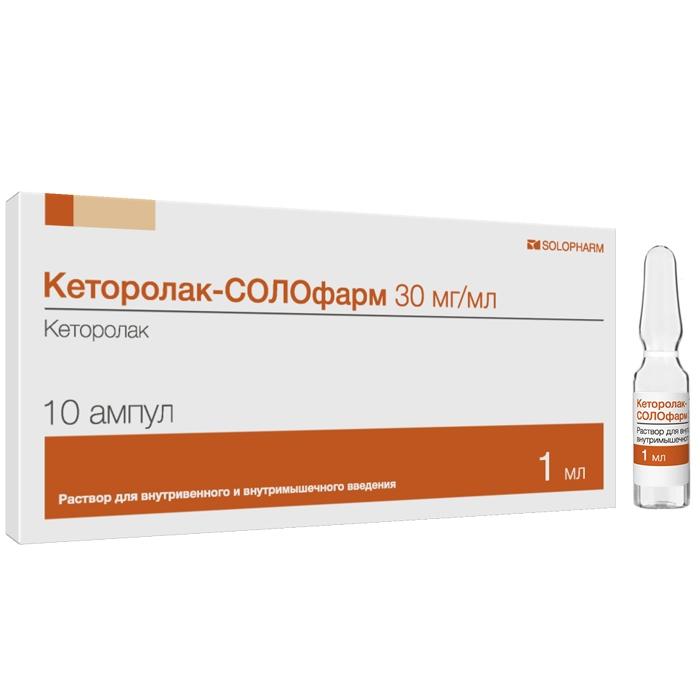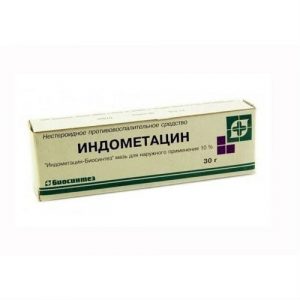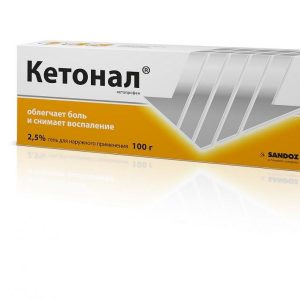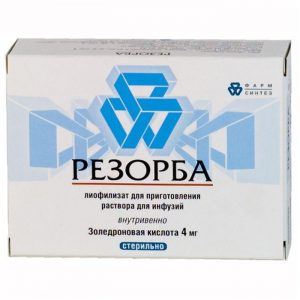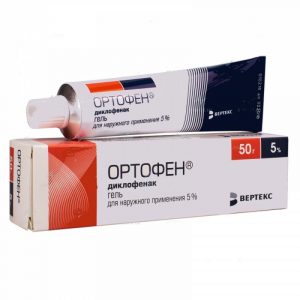Description
Release form
Solution for intravenous and intramuscular administration of 30 mg / ml.
Pharmacological action
Nonsteroidal anti-inflammatory drug.
ATX code: M01AB15
Pharmacological properties of
Pharmacodynamics
Ketorolac is a non-steroidal anti-inflammatory drug (NSAID), it has a pronounced analgesic effect, it also has anti-inflammatory and moderate antipyretic effect. The mechanism of action is associated with non-selective inhibition of the activity of cyclooxygenase 1 (COX 1) and cyclooxygenase 2 (COX 2), which catalyzes the formation of prostaglandins (Pg) from arachidonic acid, which play an important role in the pathogenesis of pain, inflammation and fever.
Ketorolac is a racemic mixture of [-] S and [+] R enantiomers, with the analgesic effect being due to the [-] S form. The strength of the analgesic effect is comparable to morphine, significantly superior to other NSAIDs. The onset of analgesic action is observed after 0.5 hours, the maximum effect is achieved after 1-2 hours and lasts about 4-6 hours.
Pharmacokinetics
Absorption
Bioavailability is complete and fast. After intramuscular injection of 30 mg, the maximum concentration (Cmax) is 1.74-3.1 μg / ml, 60 mg is 3.23-5.77 μg / ml, the time to reach maximum concentration (TCmax) is 15-73 minutes and 30-60 minutes, respectively. After intravenous administration at a dose of 15 mg, Cmax is 1.96-2.98 μg / ml, at a dose of 30 mg, Cmax is 3.69-5.61 μg / ml.
Distribution of
Communication with plasma proteins – 99%. The time to reach equilibrium concentration (Css) is 24 hours, Css with intramuscular injection of 15 mg 4 times a day is 0.65-1.13 μg / ml, 30 mg is 1.29-2.47 μg / ml.
Distribution volume – 0,15-0,33 l / kg. In patients with renal failure, the volume of distribution of ketorolac may increase by 2 times, and the volume of distribution of its R-enantiomer by 20%.
Penetrates into breast milk: after the administration of 10 mg of Ketorolac Cmax in milk
is reached after 2 hours and amounts to 7.3 ng / ml, 2 hours after the introduction of the second dose of ketorolac (when using the drug 4 times a day) – is 7.9 ng / l.
Metabolism
More than 50% of the administered dose is metabolized in the liver to form pharmacologically inactive metabolites. The main metabolites are glucuronides, which are excreted by the kidneys, and p-hydroxyketorolac. It is excreted by 91%
by the kidneys, 6% – through the intestines.
Excretion
The elimination half-life (T1 / 2) in patients with normal renal function is on average 5.3 hours (3.5–9.2 hours after intramuscular administration of 30 mg). T1 / 2 increases in elderly patients and decreases in young patients. Liver function has no effect on T1 / 2. In patients with impaired renal function with a plasma creatinine concentration of 19-50 mg / l (168-442 mmol / l) T1 / 2 is 10.3-10.8 hours, with more pronounced renal failure – more than 13, 6 hours. The total clearance with an intramuscular injection of 30 mg is 0.023 l / h / kg, with an intravenous administration of 30 mg – 0.03 l / kg / h.
Ketorolac is not excreted during hemodialysis.
Indications
Pain syndrome of severe and moderate severity: trauma, toothache, pain in the postoperative period, cancer, myalgia, arthralgia, neuralgia, sciatica, sprains, sprains, rheumatic diseases.
Designed for symptomatic therapy, reduce pain and inflammation at the time of use, does not affect the progression of the disease.
Contraindications
– hypersensitivity to any component of the
preparation – anamnestic data on an attack of bronchial obstruction, rhinitis, urticaria after taking acetylsalicylic acid or other NSAIDs (complete or incomplete combination of bronchial asthma, nasal polyacidosis and acetic acid) – hypovolemia (regardless of the cause that caused it)
– erosive and ulcerative lesions of the gastrointestinal tract in the acute stage, peptic ulcers, bleeding or high s risk of developing, hypocoagulation (including haemophilia), inflammatory bowel disease (Crohn’s disease, ulcerative colitis)
– severe liver failure or active liver disease
– severe renal failure (serum creatinine> 700 μmol / L), progressive kidney disease
– confirmed hypokalemia
– decompensated heart failure, condition after coronary artery bypass grafting – pain relief before and during surgery due to the high risk of bleeding
– intracranial hemorrhage or suspected
– confirmed hyperkalemia
– pregnancy, childbirth, period of breastfeeding
– children under 16 years of age (efficacy and safety have not been established).
Precautions
Hypersensitivity to other NSAIDs, bronchial asthma, presence of factors, increase gastrointestinal toxicity (alcoholism, smoking, cholecystitis) postoperative chronic heart failure (CHF), coronary heart disease (CHD), edematous syndrome, arterial hypertension moderate renal failure (serum creatinine 300-700 μmol / l ) cholestasis sepsis, systemic lupus erythematosus, concomitant use with other NSAIDs, prolonged use of NSAIDs, cerebrovascular disease, dyslipidemia, hyperlipidemia, diabetes mellitus, peripheral arterial disease history of gastrointestinal ulceration, the presence of H. pylori infection, severe somatic diseases, systemic connective tissue diseases, inflammatory bowel diseases without exacerbation, concomitant use of oral glucocorticosteroid drugs (including prednisone), anticoagulants (including warfarin), antiplatelet agents (including clopidogrel), selective serotonin reuptake inhibitors (including citalopram, fluoxetine, paroxetine, sertraline), advanced age (over 65 years).
Use during pregnancy and lactation
Do not take the drug during pregnancy (adverse effects on the fetal cardiovascular system – premature closure of the duct), during childbirth, in the early postpartum period (inhibits prostaglandin synthesis, the drug can adversely affect blood circulation fetus and weaken the contractile activity of the uterus, which increases the risk of uterine bleeding) and during breastfeeding (the drug passes into breast milk).
If you need to use the drug during lactation, you should stop breastfeeding.
Special instructions
Before prescribing the drug, it is necessary to clarify the issue of a previous allergy to ketorolac or other NSAIDs. Due to the risk of allergic reactions, the first dose is administered under close medical supervision. Hypovolemia increases the risk of developing nephrotoxic adverse reactions. If necessary, it can be used with opioid analgesics.
It is not recommended to use as a means for sedation, maintenance of anesthesia. When taken together with other NSAIDs, fluid retention, decompensation of cardiac activity, and increased blood pressure may occur. The risk of developing drug complications increases with prolonged treatment (in patients with chronic pain) and an increase in the dose of the drug. To reduce the risk of developing NSAID gastropathy, antacid drugs, misoprostol, omeprazole are used.
Effect on the ability to drive vehicles and mechanisms
During treatment, care must be taken when driving vehicles and engaging in potentially dangerous activities that require increased concentration of attention and speed of psychomotor reactions.
Composition of
1 ml of the preparation contains:
Active ingredient:
Ketorolac tromethamine 30 mg
Excipients:
Propylene glycol 400.00 mg
Ethanol 95% 115.00 mg
Sodium chloride 4.35 dihydrate dihydrate dard ) 1.00 mg
Octoxynol 10 (TritonВ® X-100) 0.07 mg
1 M sodium hydroxide solution to pH 7.0-8.0
Water for injection up to 1 ml
Description
Transparent, colorless or slightly colored liquid .
Dosage and Administration
Intramuscularly, intravenously.
The drug is intended for short-term use.
The drug is administered intravenously in a stream for at least 15 seconds or intramuscularly slowly, deep into the gluteus maximus, in minimally effective doses with a minimum short course. If necessary, at the same time, opioid analgesics can be additionally used in reduced doses.
Single doses for single administration:
– patients aged 16 to 65 years and weighing more than 50 kg – 60 mg (2 ml) intramuscularly or 30 mg (1 ml) intravenously
– patients older than 65 years or with renal failure (creatinine serum 170-442 ?mol / l), or with a body weight of less than 50 kg – 30 mg (1 ml) intramuscularly or 15 mg (0.5 ml) intravenously.
Doses for repeated administration:
– patients from 16 to 65 years old and weighing more than 50 kg – 30 mg (1 ml) intramuscularly or intravenously, if necessary, every 6 hours. The maximum daily dose should not exceed 90 mg (3 ml) of
– for patients older than 65 years of age, or with renal failure (serum creatinine 170-442 ?mol / L), or with a body weight of less than 50 kg – 15 mg (0.5 ml) intramuscularly or intravenously, if necessary, every 6 hours. The maximum daily dose should not exceed 60 mg (2 ml).
The maximum duration of treatment should not exceed 2 days. When switching from parenteral administration to oral administration, the total daily dose of both dosage forms on the day of transfer should not exceed 90 mg for patients under 65 years of age and 60 mg for patients older than 65 years of age or with renal failure or weighing less than 50 kg. In this case, the dose of the drug in tablets on the day of transition should not exceed 30 mg.
Drug interaction
The simultaneous use of ketorolac with other NSAIDs, glucocorticosteroids, ethanol, corticotropin, calcium preparations increases the risk of ulceration of the gastrointestinal mucosa and the development of gastrointestinal bleeding.
Concomitant use with paracetamol increases the nephrotoxicity of ketorolac, with methotrexate increases hepato- and nephrotoxicity. Do not use simultaneously with 8 paracetamol for more than 2 days. The combined use of ketorolac and methotrexate is possible only when using low doses of the latter and controlling its concentration in blood plasma. When prescribed with other nephrotoxic drugs (including gold preparations), the risk of developing nephrotoxicity increases.
Probenecid reduces plasma clearance and the volume of distribution of ketorolac, increases its concentration in blood plasma and increases its half-life. The simultaneous use with anticoagulants – coumarin and indandiol derivatives, heparin, thrombolytics (alteplase, streptokinase, urokinase), antiplatelet drugs, cephalosporins, valproic acid and acetylsalicylic acid increases the risk of bleeding.
Reduces the effect of antihypertensive and diuretic drugs (reduces the synthesis of prostaglandins in the kidneys). Medicines that block tubular secretion reduce the clearance of ketorolac and increase its concentration in blood plasma. When combined with opioid analgesics, the doses of the latter can be significantly reduced.
Increases the hypoglycemic effect of insulin and oral hypoglycemic drugs (dose recalculation required). Increases the plasma concentration of verapamil and nifedipine. Myelotoxic drugs increase the hematotoxicity of the drug. The simultaneous use of lithium salts, pentoxifylline, zidovudine, digoxin, tacrolimus, selective serotonin reuptake inhibitors, antacids, mifepristone is not recommended.
The drug cannot be mixed in the same syringe with morphine sulfate, meperidine hydrochloride, promethazine hydrochloride or hydroxyzine hydrochloride (ketorolac precipitates from solution). Pharmaceutically incompatible with tramadol solution, lithium preparations.
Storage Conditions
Do not store above 25 C.
Keep out of the reach and sight of children.
Expiration
3 years.
Do not use after the expiry date!
active substance
Ketorolac
Conditions of release from
pharmacies Prescription
